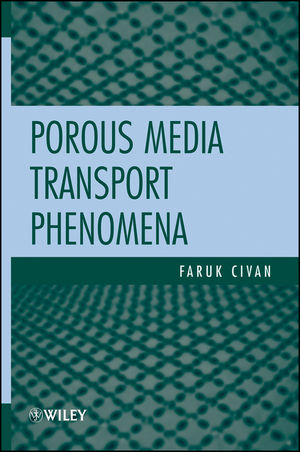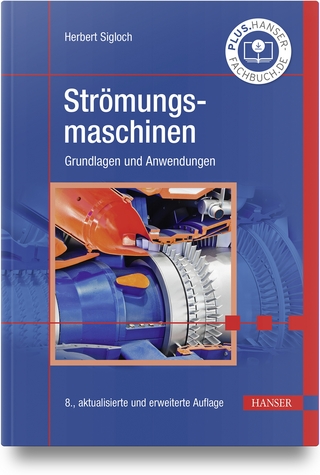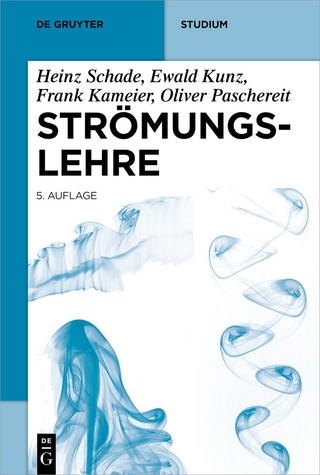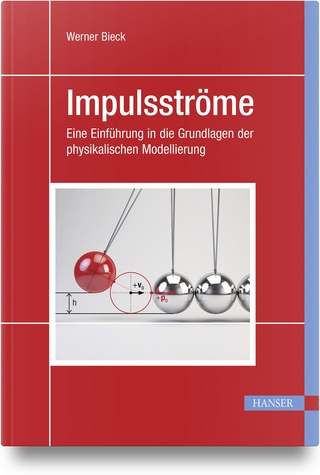
Porous Media Transport Phenomena
John Wiley & Sons Inc (Verlag)
978-0-470-64995-4 (ISBN)
- Titel z.Zt. nicht lieferbar
- Versandkostenfrei innerhalb Deutschlands
- Auch auf Rechnung
- Verfügbarkeit in der Filiale vor Ort prüfen
- Artikel merken
The book that makes transport in porous media accessible to students and researchers alike
Porous Media Transport Phenomena covers the general theories behind flow and transport in porous mediaa solid permeated by a network of pores filled with fluidwhich encompasses rocks, biological tissues, ceramics, and much more. Designed for use in graduate courses in various disciplines involving fluids in porous materials, and as a reference for practitioners in the field, the text includes exercises and practical applications while avoiding the complex math found in other books, allowing the reader to focus on the central elements of the topic.
Covering general porous media applications, including the effects of temperature and particle migration, and placing an emphasis on energy resource development, the book provides an overview of mass, momentum, and energy conservation equations, and their applications in engineered and natural porous media for general applications. Offering a multidisciplinary approach to transport in porous media, material is presented in a uniform format with consistent SI units.
An indispensable resource on an extremely wide and varied topic drawn from numerous engineering fields, Porous Media Transport Phenomena includes a solutions manual for all exercises found in the book, additional questions for study purposes, and PowerPoint slides that follow the order of the text.
FARUK CIVAN is a Miller Chair Professor in the Mewbourne School of Petroleum and Geological Engineering at the University of Oklahoma. He has been teaching graduate courses on porous media for twenty-five years, and has published over two hundred and seventy journal and conference papers, a book, and several book chapters.
Preface xv About the Author xix
Chapter 1. Overview 1
1.1 Introduction 1
1.2 Synopses of Topics Covered in Various Chapters 3
Chapter 2. Transport Properties of Porous Media 7
2.1 Introduction 7
2.2 Permeability of Porous Media Based on the Bundle of Tortuous Leaky-Tube Model 10
2.3 Permeability of Porous Media Undergoing Alteration by Scale Deposition 33
2.4 Temperature Effect of Permeability 44
2.5 Effects of Other Factors on Permeability 54
2.6 Exercises 54
Chapter 3. Macroscopic Transport Equations 57
3.1 Introduction 57
3.2 REV 58
3.3 Volume-Averaging Rules 59
3.4 Mass-Area Averaging Rules 67
3.5 Surface Area Averaging Rules 68
3.6 Applications of Volume and Surface Averaging Rules 68
3.7 Double Decomposition for Turbulent Processes in Porous Media 70
3.8 Tortuosity Effect 73
3.9 Macroscopic Transport Equations by Control Volume Analysis 74
3.10 Generalized Volume-Averaged Transport Equations 76
3.11 Exercises 76
Chapter 4. Scaling and Correlation of Transport in Porous Media 79
4.1 Introduction 79
4.2 Dimensional and Inspectional Analysis Methods 81
4.3 Scaling 84
4.4 Exercises 92
Chapter 5. Fluid Motion in Porous Media 97
5.1 Introduction 97
5.2 Flow Potential 98
5.3 Modification of Darcy’s Law for Bulk- versus Fluid Volume Average Pressures 99
5.4 Macroscopic Equation of Motion from the Control Volume Approach and Dimensional Analysis 102
5.5 Modification of Darcy’s Law for the Threshold Pressure Gradient 105
5.6 Convenient Formulations of the Forchheimer Equation 108
5.7 Determination of the Parameters if the Forchheimer Equation 111
5.8 Flow Demarcation Criteria 115
5.9 Entropy Generation in Porous Media 117
5.10 Viscous Dissipation on Porous Media 123
5.11 Generalized Darcy’s Law by Control Volume Analysis 124
5.12 Equation of Motion for Non-Newtonian Fluids 134
5.13 Exercises 138
Chapter 6. Gas Transport in Tight Porous Media 145
6.1 Introduction 145
6.2 Gas Glow through a Capillary Hydraulic Tube 146
6.3 Relationship between Transports Expressed on Different Bases 147
6.4 The Mean Free Path of Molecules: FHS versus VHS 149
6.5 The Knudsen Number 150
6.6 Flow Regimes and Gas Transport as Isothermal Conditions 152
6.7 Gas Transport at Nonisothermal Conditions 159
6.8 Unified Hagen-Poiseuille-Type Equation fro Apparent Gas Permeability 160
6.9 Single-Component Gas Glow 165
6.10 Multicomponent Gas Flow 166
6.11 Effect of Different Flow Regimes in a Capillary Flow Path and the Extended Klinkenberg Equation 168
6.12 Effect of Pore Size Distribution on Gas Flow through Porous Media 170
6.13 Exercises 174
Chapter 7. Fluid Transport Through Porous Media 177
7.1 Introduction 177
7.2 Coupling Single-Phase Mass and Momentum Balance Equations 178
7.3 Cylindrical Leaky-Tank Reservoir Model Including the Non-Darcy Effect 179
7.4 Coupling Two-Phase Mass and Momentum Balance Equations for Immiscible Displacement 186
7.5 Potential Flow Problems in Porous Media 200
7.6 Streamline/Stream Tube Formulation and Front Tracking 205
7.7 Exercises 218
Chapter 8. Parameters of Fluid Transfer in Porous Media 227
8.1 Introduction 227
8.2 Wettability and Wettability Index 230
8.3 Capillary Pressure 231
8.4 Work of Fluid Displacement 234
8.5 Temperature Effect on Wettability-Related Properties of Porous Media 235
8.6 Direct Methods for the Determination of Porous Media Flow Functions and Parameters 238
8.7 Indirect Methods for the Determination of Porous Media Flow Functions and Parameters 259
8.8 Exercises 276
Chapter 9. Mass, Momentum, and Energy Transport in Porous Media 281
9.1 Introduction 281
9.2 Dispersive Transport of Species in Heterogeneous and Anisotropic Porous Media 282
9.3 General Multiphase Fully Compositional Nonisothermal Mixture Model 288
9.4 Formulation of Source/Sink Terms in Conservation Equations 292
9.5 Isothermal Black Oil Model of a Nonvolatile Oil System 295
9.6 Isothermal Limited Compositional Model of a Volatile Oil System 298
9.7 Flow of Gas and Vaporizing Water Phases in the Near-Wellbore Region 299
9.8 Flow of Condensate and Gas Phase Containing Noncondensable Gas Species in the Near-Wellbore Region 301
9.9 Shape-Averaged Formulations 305
9.10 Conductive Heat Transfer with Phase Change 307
9.11 Simultaneous Phase Transition and Transport in Porous Media Containing Gas Hydrates 328
9.12 Modeling Nonisothermal Hydrocarbon Fluid Flow Considering Expansion/Compression and Joule-Thomson Effects 338
9.13 Exercises 346
Chapter 10. Suspended Particulate Transport in Porous Media 353
10.1 Introduction 353
10.2 Deep-Bed Filtration under Nonisothermal Conditions 355
10.3 Cake Filtration over an Effective Filter 370
10.4 Exercises 379
Chapter 11. Transport in Heterogeneous Porous Media 383
11.1 Introduction 383
11.2 Transport Units and Transport in Heterogeneous Porous Media 385
11.3 Models for Transport in Fissured/Fractured Porous Media 388
11.4 Species Transport in Fractured Porous Media 394
11.5 Immiscible Displacement in Naturally Fractured Porous Media 396
11.6 Method of Weighted Sum (Quadrature) Numerical Solutions 410
11.7 Finite Difference Numerical Solution 415
11.8 Exercises 425
References 429
Index 455
| Verlagsort | New York |
|---|---|
| Sprache | englisch |
| Maße | 158 x 236 mm |
| Gewicht | 885 g |
| Themenwelt | Naturwissenschaften ► Chemie |
| Naturwissenschaften ► Physik / Astronomie ► Strömungsmechanik | |
| Technik ► Bauwesen | |
| Technik ► Maschinenbau | |
| Technik ► Umwelttechnik / Biotechnologie | |
| ISBN-10 | 0-470-64995-X / 047064995X |
| ISBN-13 | 978-0-470-64995-4 / 9780470649954 |
| Zustand | Neuware |
| Informationen gemäß Produktsicherheitsverordnung (GPSR) | |
| Haben Sie eine Frage zum Produkt? |
aus dem Bereich


